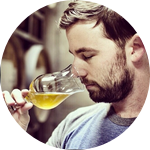Project Results
Beer brewers can use malted barley as a source of naturally-occurring bacteria in the production of sour wort. This experiment is designed to assess the variation of bacteria found in malted barley across variables including harvest year, varietal, origin, and processing. The results show there is much in common between bacteria found in malted barley and resulting organic acid and alcohol production regardless of variables.
About This Project
Sour beers are likely the original beer style and have made a recent comeback in terms of popularity among craft beer enthusiasts. They are made with a bacterial and fungal mix rather than pure cultures of Saccharomyces. yeast as in typical ales and lagers. However, the suite of different microbes and their relative abundances during the course of souring and fermentation remain a mystery. We aim to map part of the sour beer microbiome and identify the organic acids these microbes produce.
Ask the Scientists
Join The DiscussionWhat is the context of this research?
Sour beers are delicious, refreshing, and a microbiological mystery. A typical ale is made by using yeast to convert sugar from malted barley (wort) into alcohol and carbon dioxide. During sour wort production, naturally occurring bacteria and wild yeast found on malted grain can be used as an affordable way to inoculate and sour wort. With temperature control, one can promote strains of bacteria in the wort to produce lactic acid while limiting the amount of undesirable flavor compounds. Although some have investigated the microbes present in Belgian-style spontaneously fermented beer, the microbial community found on grain and how it changes during the production of sour wort (the sour beer microbiome) is largely unknown.
What is the significance of this project?
Sour beers are a trending category among American craft beer drinkers, but making them is more of an art than a science because we simply don't know enough about the process. When a batch fails for any reason (e.g., poor souring, undesirable byproducts, poor fermentation, or poor carbonation), it's a waste of time and money for the brewers, resulting in higher prices for beer drinkers. If we can understand souring at the microbial level, we can tame it, yielding predictable batches of beer time and again. Additionally, the affordability of utilizing naturally occurring bacteria found on grain (sour-mashing or sour-wort), if controllable, will yield an easy, accessible way for all brewers to experiment more with sour beers.
What are the goals of the project?
The object of this experiment is to determine the microflora on various malted grains and to sample souring beer at various time points to determine which microbes thrive, grow, and ferment during wort-souring. Blue Owl Brewing will collect the samples over the course of 24 h. The Bochman lab at Indiana University will then isolate microbial DNA and prepare next-generation sequencing libraries. The DNAs will be sequenced and the samples compared to one another to: 1) determine the species present and their relative abundances at each time point; and 2) how that microbial community changes with time. The organic acids in the final beer (lactic acid, acetic acid, etc.) will also be identified, as these are the compounds that the tongue recognizes as "sour".
Budget
Determining the sour beer microbiome requires next-generation sequencing. The Sequencing library prep kits and the preparation itself are vital to a successful, data-rich sequencing run on the MiSeq v3, and custom bioinformatics analysis is required to make sense of the huge amounts of data that next-gen sequencing provides. We are also interested in the organic acids produced by the microbes during souring and fermentation (as they account for much of the flavor in the finished beer), and high pressure liquid chromatography (HPLC) is the gold standard to analyze these secondary metabolites.
Endorsed by
Meet the Team
Affiliates
Matthew L. Bochman
I've been working in research labs for almost 20 years, using the model organism Saccharomyces cerevisiae to answer a variety of scientific questions. For the same amount of time, I've been an active homebrewer, making beer, hard cider, and kombucha. As a PI now, I'm interested in fusing my two yeast activities into one, and I've initiated several fermentation-themed projects, as well as started a business to provide yeast and lab services to craft and homebrewers.
Jeff Young
I have been brewing for over a decade and was previously an analytical chemist at a pharmaceutical company. My passions for art, science, and engineering come together in the brewhouse! I left my previous brewery, Black Star Co-op Pub and Brewery, to focus solely on sour-mashing and the novel, seemingly endless possibilities of integrating sourness to any beer style.
Project Backers
- 68Backers
- 106%Funded
- $6,246Total Donations
- $91.85Average Donation





